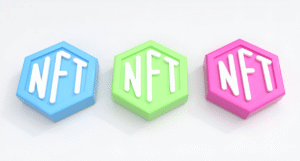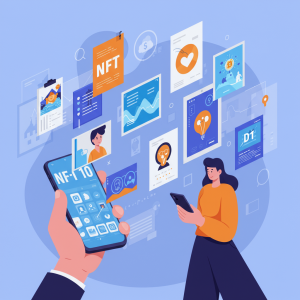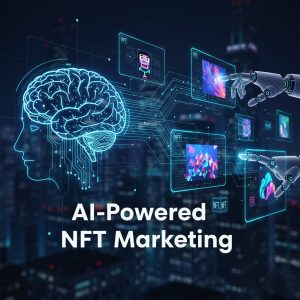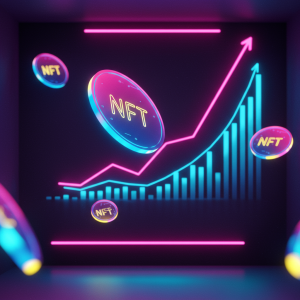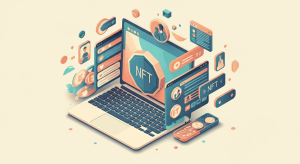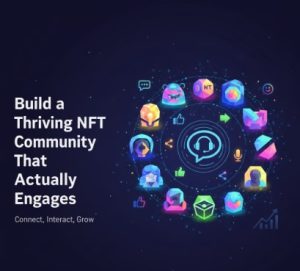Crafting NFT Project Roadmaps That Maintain Community Engagement

The initial excitement surrounding an NFT launch inevitably fades. Collections that initially generated tremendous enthusiasm often struggle to maintain community interest beyond their mint date. This post-launch engagement cliff represents perhaps the most significant challenge facing NFT projects today. While impressive artwork and clever marketing might drive successful mints, thoughtfully constructed roadmaps ultimately determine whether projects build enduring communities or fade into blockchain obscurity.
Beyond the Mint: Understanding the Engagement Challenge
The fundamental challenge facing NFT projects stems from attention economics. During mint periods, projects benefit from natural excitement around newness, potential profit, and collection completion. This concentrated attention creates community momentum that requires no additional stimulus. However, once minting concludes, this natural attention driver disappears, creating an engagement vacuum that roadmaps must deliberately fill.
Several factors complicate post-mint community maintenance. Market fluctuations create emotional volatility as collectors see valuations rise and fall. Competing projects constantly emerge, pulling attention toward newer opportunities. The natural human tendency toward novelty-seeking works against established collections. Without deliberate counterbalancing through ongoing value creation, communities naturally disperse.
The consequences of failing to maintain post-mint engagement extend beyond community dissolution. Secondary market activity typically collapses without sustained interest, damaging holder value and creator reputations. Future collection launches become progressively more difficult as previous community members recall previous disappointments. Creator brands suffer lasting damage that extends beyond single projects.
Successful projects recognize these challenges and develop roadmaps specifically designed to counteract these natural attention dispersal tendencies. They create sustained value delivery mechanisms that provide ongoing reasons for community participation while building toward meaningful long-term visions that transcend initial collection excitement.
Core Elements of Effective NFT Roadmaps
The most resilient NFT communities benefit from roadmaps built around several foundational principles that consistently foster engagement across market conditions and project types.
Vision articulation provides the essential foundation. Effective roadmaps begin by clearly communicating why the project exists beyond profit-seeking—establishing a meaningful purpose that creates emotional investment beyond potential returns. This vision creates community cohesion even during difficult market periods by ensuring members share motivation beyond speculation.
The Friends With Benefits project demonstrates this principle effectively. Their roadmap centers on building a decentralized cultural organization that transcends typical NFT collection dynamics. This clear purpose creates community alignment even during crypto market volatility because members connect with the project’s cultural ambitions rather than merely financial outcomes.
Tangible value delivery mechanisms provide the practical engagement substance. Successful roadmaps include specific ways holders receive ongoing utility, entertainment, status, or financial benefits through continued participation. These mechanisms transform static collections into dynamic ecosystems with reasons for continued interaction beyond simple ownership.
At NFTMarketo, our research indicates that roadmaps delivering a mixture of value types—combining status elements, utility functions, entertainment components, and financial opportunities—consistently outperform those focused on single value categories. This diversification creates resilience when particular value types lose market favor.
Achievable milestone sequencing establishes credibility while maintaining excitement. Effective roadmaps balance near-term deliverables that demonstrate execution capability with longer-term ambitious goals that sustain vision enthusiasm. This careful sequencing builds trust through consistent delivery while preventing roadmap completion from extinguishing community excitement.
Community involvement mechanisms represent another crucial element. Projects that incorporate holder governance, contribution opportunities, and co-creation experiences transform passive collectors into active stakeholders. This participation dramatically increases engagement persistence by creating personal investment beyond financial exposure.
Adaptation frameworks enable resilience against changing market conditions. Rather than presenting entirely fixed paths, sophisticated roadmaps include explicit processes for incorporating community feedback, responding to market shifts, and evolving based on execution learnings. This flexibility prevents roadmap obsolescence when initial assumptions prove incorrect.
Temporal Balancing: The Essential Rhythm of Engagement
Beyond content elements, effective roadmaps carefully balance different time horizons to maintain consistent engagement while building toward meaningful outcomes. This temporal orchestration requires deliberate planning across multiple timescales.
Immediate gratification components address human psychological needs for quick feedback and regular reinforcement. Daily interactions, weekly events, and monthly deliverables create consistent touchpoints that maintain community presence and conversation. Without these high-frequency elements, communities struggle to maintain cohesion between major milestones.
Medium-term development initiatives provide substance beyond simple engagement mechanics. Quarterly feature launches, seasonal events, and collaborative projects create meaningful anticipation cycles that give communities reasons to remain connected beyond daily interactions. These initiatives often represent the substantive utility that distinguishes meaningful projects from temporary excitement.
Long-term vision components establish direction and purpose beyond immediate deliverables. Annual goals, multi-year development plans, and ultimate project aspirations provide context that helps communities weather inevitable short-term challenges. Without these anchoring elements, projects often feel rudderless despite regular activities.
The interplay between these timeframes creates essential rhythm variations that prevent engagement fatigue. Projects that maintain only high-frequency activities without meaningful developments often experience enthusiasm decay as interactions feel increasingly hollow. Conversely, projects focused exclusively on distant goals without regular community touchpoints typically lose cohesion before reaching their objectives.
Implementation Patterns: From Concept to Execution
Translating roadmap concepts into effective execution requires specific implementation approaches that successful projects have refined through experience and iteration.
Transparent communication frameworks establish essential community trust. Effective projects maintain regular update cadences through consistent channels, balancing formal announcements with informal community conversations. They acknowledge both successes and challenges honestly, building credibility through transparency rather than selective disclosure.
Visual representation significantly impacts roadmap effectiveness. The most compelling roadmaps transform abstract concepts into visually engaging formats that community members easily comprehend and share. These visual elements become reference points in community discussions while serving as powerful marketing assets for attracting new participants.
Responsibility allocation moves roadmaps from aspirational documents to actionable plans. Successful implementation requires clear ownership of specific deliverables with appropriate accountability mechanisms. Projects that publicly assign responsible parties and deadlines demonstrate serious commitment while creating natural progress checkpoints.
Milestone celebration rituals maintain momentum through acknowledgment and reinforcement. Effective communities develop specific practices for marking roadmap achievements, creating collective experiences that strengthen community bonds while demonstrating tangible progress. These celebrations transform abstract progress into memorable shared experiences.
Feedback incorporation systems transform roadmaps from static documents to living frameworks that evolve with community needs. Regular surveys, town halls, and governance processes allow holder input to meaningfully influence development priorities, creating both better outcomes and stronger stakeholder investment.
Emerging Models: Beyond Traditional Roadmaps
While traditional linear roadmaps dominated early NFT projects, several innovative alternatives have emerged that offer fresh approaches to sustained engagement.
Hub-and-spoke models organize development around central community platforms with multiple independent initiatives extending outward. This approach enables diverse community interests to find engagement paths without requiring universal participation in all aspects. The flexibility accommodates varying engagement levels while maintaining cohesive community identity.
Progression systems incorporate game-inspired advancement mechanics into roadmap structures. Community members unlock new opportunities, capabilities, or experiences through specific actions or achievements. This approach gamifies engagement while creating natural onboarding paths for new members at various stages of project development.
Ecosystem expansion frameworks focus on building interconnected projects sharing common elements rather than single collection enhancement. These approaches leverage initial community formation to bootstrap related initiatives, creating broader engagement ecosystems that capture diverse interests while maintaining shared identity elements.
Seasonal structures borrow from entertainment industry models, organizing development into distinct chapters with unique themes, mechanics, and community activities. This approach creates natural renewal points for reengaging lapsed community members while preventing monotony through regular reinvention.
Common Pitfalls and Their Remedies
Despite best intentions, many NFT roadmaps encounter predictable challenges that undermine their effectiveness. Understanding these common pitfalls helps projects avoid or address them proactively.
Overpromising represents perhaps the most common roadmap failure. Ambitious projects often include deliverables exceeding their realistic capabilities, creating inevitable disappointment when deadlines pass without delivery. Successful projects counter this tendency by conservatively estimating timeframes, breaking complex deliverables into smaller milestones, and explicitly acknowledging uncertainty around innovative features.
Market dependency creates another frequent vulnerability. Roadmaps heavily reliant on rising token values or increasing collection prices inevitably falter during market downturns. Resilient projects design value delivery mechanisms that function independently of market conditions, ensuring community benefits persist even during challenging price environments.
Community polarization often emerges as projects evolve. Different holder segments develop conflicting priorities, creating difficult governance challenges that sometimes paralyze development. Effective projects anticipate these divergences by designing explicit prioritization mechanisms and creating separate value streams for different community segments.
Execution transparency shortfalls damage community trust even when progress occurs. Projects working diligently behind closed doors often face community skepticism about their continued commitment. Regular progress updates—including honest discussions of challenges—maintain faith during inevitable development complexities.
Vision drift gradually erodes community cohesion when projects chase trendy opportunities without clear connection to core purposes. Successful projects evaluate potential expansions against explicit vision criteria, ensuring continued focus despite tempting market opportunities that might dilute their fundamental identity.
Conclusion
NFT project roadmaps represent much more than marketing documents or aspirational statements—they function as essential architecture for community formation and sustained engagement. The most successful examples transform initial collection excitement into enduring community participation through carefully structured value delivery, meaningful involvement opportunities, and compelling long-term vision.
For creators developing new projects, roadmap construction warrants investment comparable to artwork development and launch marketing. The post-mint community trajectory depends fundamentally on roadmap quality, with thoughtful approaches consistently outperforming beautiful collections lacking substantive plans. The most valuable projects invariably combine artistic excellence with sophisticated engagement strategies.
For collectors evaluating potential acquisitions, roadmap analysis provides crucial insight beyond immediate aesthetic appeal or mint mechanics. Patterns evident in roadmap structure and communication often predict project longevity more accurately than initial market reception or team reputation. Discerning collectors increasingly scrutinize these elements when making investment decisions.
As the NFT space matures from speculation-driven collecting toward utility-centered ecosystems, roadmap sophistication increasingly differentiates successful projects from temporary phenomena. The projects establishing enduring communities invariably build around carefully constructed engagement frameworks that transform initial excitement into sustained participation. Their roadmaps serve not as marketing promises but as architectural blueprints for vibrant digital communities.


